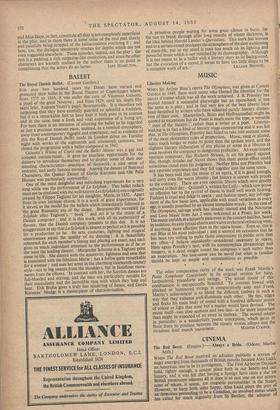BALLET
FOR over two hundred years the Danes have nursed and protected their ballet in the Royal Theatre at Copenhagen where, from 1775 to 1816, it was under the care of Vincenzo Galeotti, a pupil of the great Noverre ; and from 1829, until his death fifty years later, Auguste Vestri's pupil, Bournonville. It is therefore not surprising that they have carefully guarded so splendid a tradition, but it is a remarkable feat to have kept it both pure in its essence . and at the same time a fresh and vital expression of a living art. For here there is no intention of allowing the ballet to be regarded as just a precious museum piece, isolated, in a rarefied atmosphere, away from contemporary thaught and experience, and as evidence of this the Royal Danish Baffet made its London debut on Tuesday night with works of the eighteenth and nineteenth centuries, but closed the programme with a ballet composed in 1942.
Galeotti's Whims of Cupid and the Ballet Master was a gay and compact curtain-raiser. It gave an excellent opportunity for the dancers to introduce themselves and to display some of their out- standing characteristics—precigion of footwork, a nice sense of restraint, and justly famous miming. Among the dances of National Characters, the Quaker Dance of Gerda Karstens and Ole Palle Hansen was particularly noteworthy..
One of the most delightful and refreshing experiences for a very long while was the performance of La Sylphide. This ballet (which must not be confused with the well-known Les Syl ph ides) was originally created by Filippo Taglioni for his daughter, Marie, in 1832. Apart from its own intrinsic charm, it is a work of great importance, for it served as the model for the ballets which immediately followed in the great Romantic era of the dance. Bournonville recreated La Sylphide after Taglioni's " book " and set it to the music of a Danish composer ; and it is this work, with all its authenticity of flavour, that the Danish company presents to this day. it is no exaggeration to say that La Sylphide is almost as perfect as it is possible for a production to be. Its sets, costumes, lighting and magical contrivances equal the quality of its dancing ; it is beautifully rehearsed, for each member's timing and placing are exact, and each gives as much individual attention to the performance as if he or she were the leading dancer. Margrethe Schanne is a Taglioni print come to life. She dances with the sensitivity, lightness and ease that is associated with the fabulous Marie ; has a ballot, quite remarkable for a woman ; and uses her arms in the charming nineteenth-century style—not in big sweeps from the shoulders, but in fastidious move- ments from the elbows. In contrast with her, the Scottish dances are full-blooded and stirring, and the men are particularly notable for their masculinity and the incredible ease with which they 'leap and beat. Erik Bruhn gives a truly fine rendering of James, and Gerda Karstens' Madge is a masterpiece of characterisation. A primitive people waiting for some great silence to burst, for the sun to break through after long months of winter darkness, is the idea behind Harold Lander's Qarrtsiluni. This work has tension and to a certain extent produces the atmosphere of the slow awakening of mass-life, but to my mind it rests too much on its lighting and powerful music which is not matched by its choreography. Although it is not meant to be a ballet with a literary story as its background, but the evocation of a mood, it seems to have too little shape to be


































 Previous page
Previous page